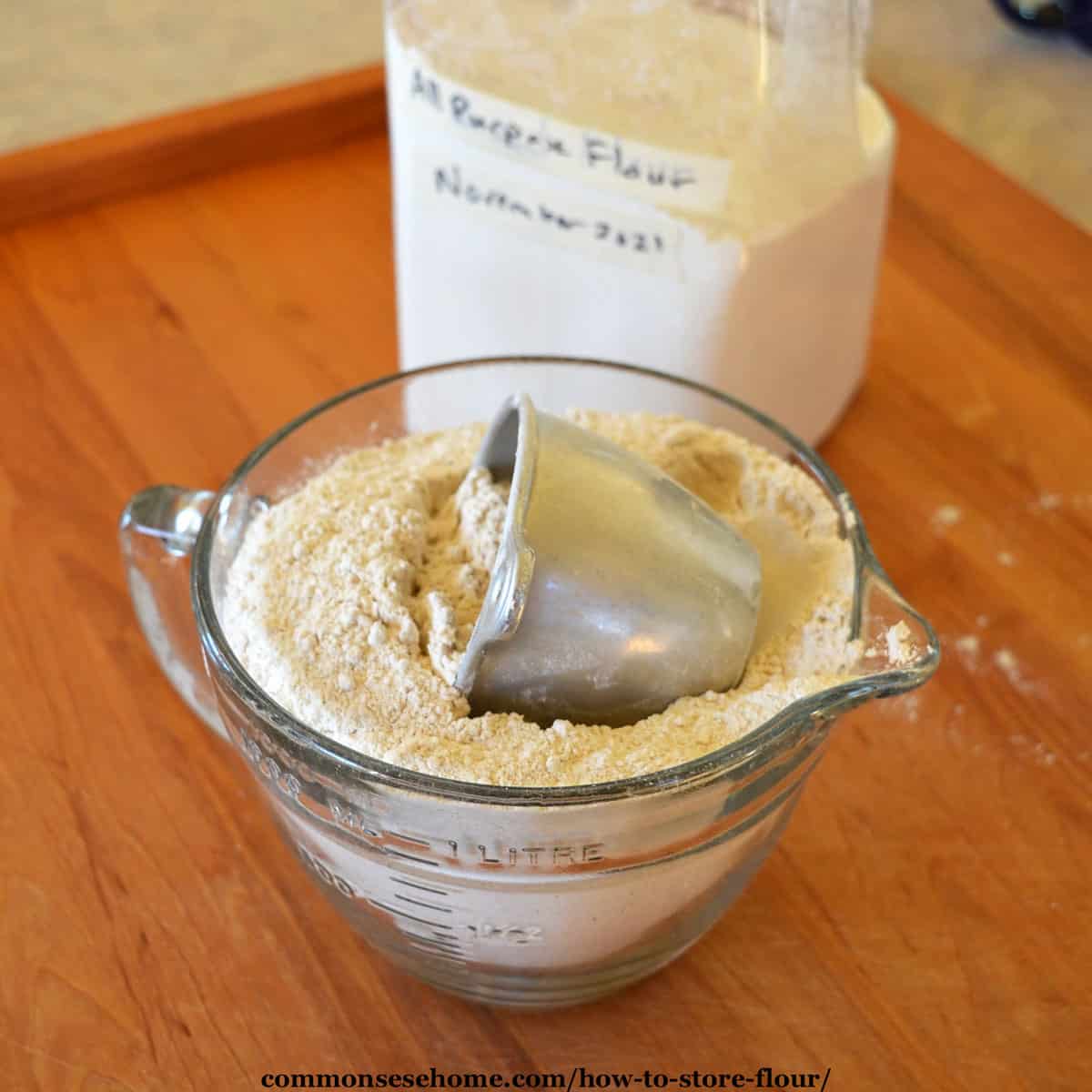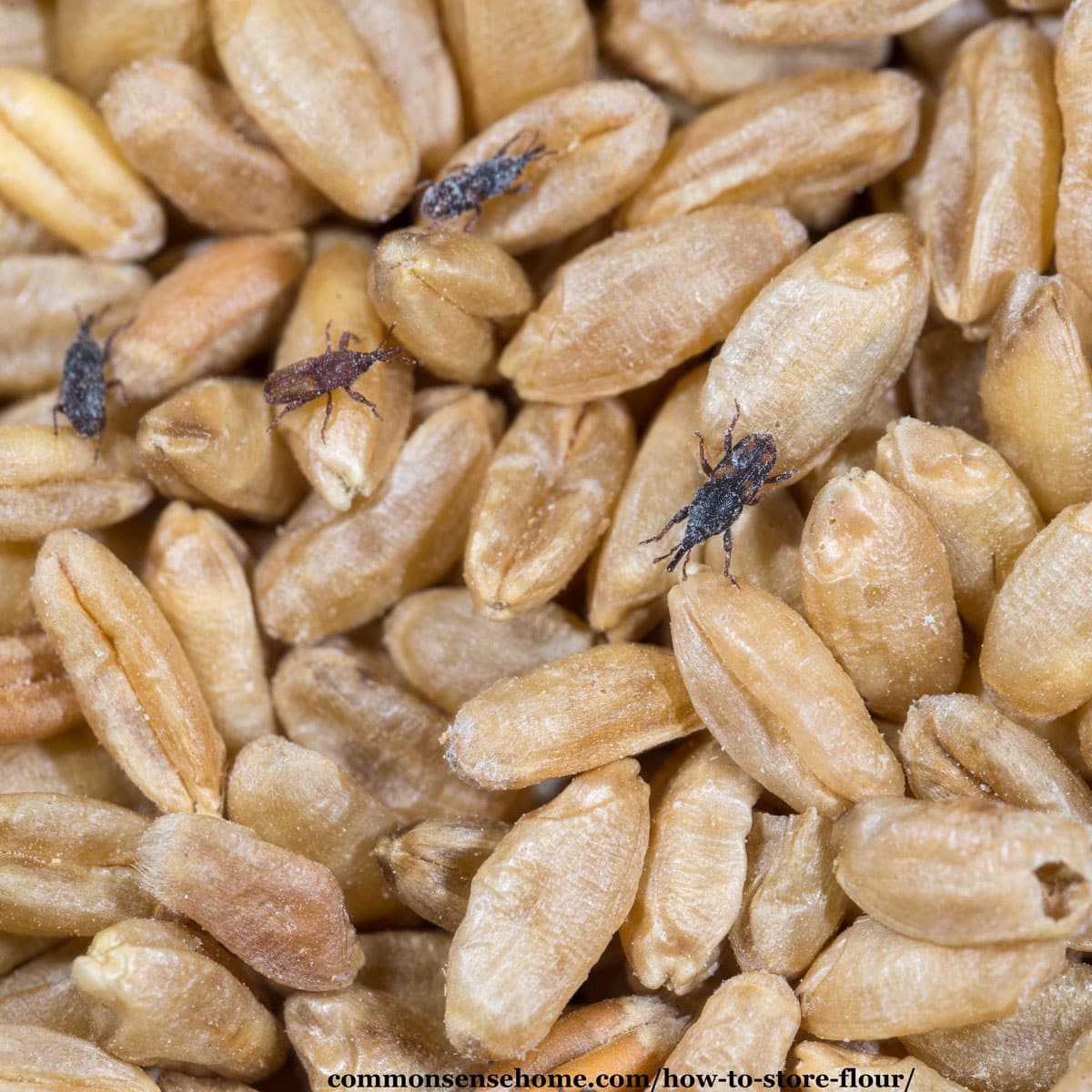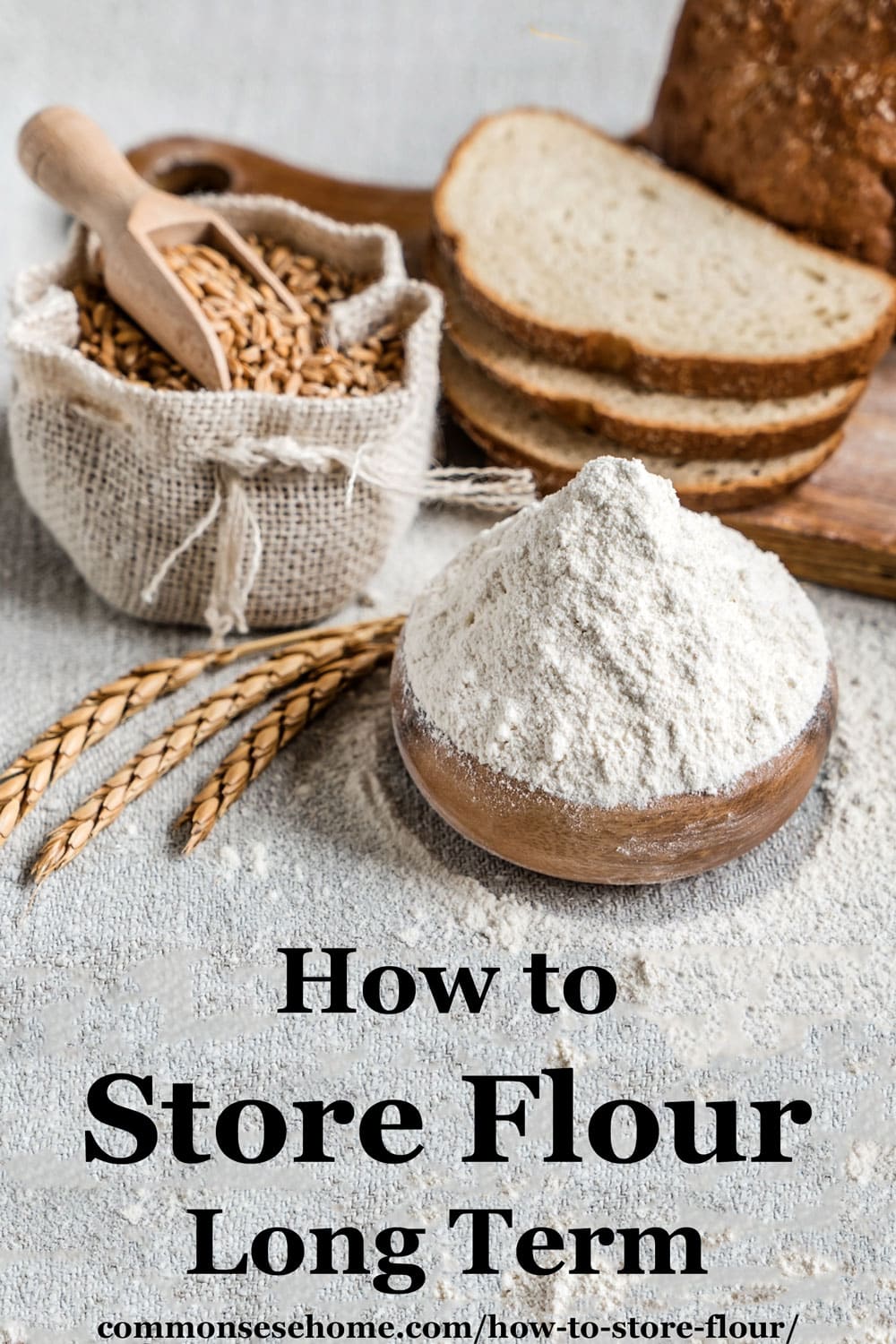How to Store Flour Long Term
This post may contain affiliate links. Read my full disclosure here.
Buying in bulk is a good way to save money, but not if you don’t use what you buy before it spoils. We’ll share how to store flour long term and short term to keep it fresh and your baked goods tasty.
If you’re prepping on a budget, buying bulk kitchen staples is more cost effective than buying premade emergency meals. Though it’s gotten a bad rap in recent years, wheat flour has fed millions for centuries.

Types of Flour
Flour is made from finely ground grains, roots, nuts, or even dried vegetables. Wheat flour is what most people think of as “flour”, unless otherwise specified.
Other types of flour include: gluten free flour blends, rice flour, almond flour, chestnut flour, corn flour and many others.
Wheat flour is made with different types of wheat and different types of processing for different uses. There’s hard wheat with higher protein for bread baking, soft wheat for pastries and more delicate baked goods, durum wheat for pasta, heirloom wheats like Einkorn, and more.
When it comes to long term storage, refined white flour is the preferred option.
I’m not talking about bleached, bromated, and enriched flour, just flour with the wheat germ and bran removed. The germ and bran contain natural oils, and those oils go rancid in storage.

Country Life Natural Foods carries bulk Gold N White flour in 5, 25 and 50 pound bags. You can find the Gold N White flour here – make sure code COMMONSENSE is present at checkout for a 10% discount.
We also like King Arthur flour, and Bob’s Red Mill flour. King Arthur is excellent flour. You will notice the difference in your baking. Bob’s tends to have a coarser grind, and they focus more on whole grain flours, which don’t keep as well. It’s good for more rustic baking.
How to Store Flour to Prevent Bugs and Keep it Fresh
First, check the “Best by” date on your flour. In a cool, dry location, flour will keep in it’s original packaging for at least a month after its Best by date. If you use your flour promptly, it’s okay to keep it in the bag.
That said, if you live in a warm, humid area, or want to store bulk flour, it’s best to take some precautions.
Use Airtight Containers
Flour absorbs moisture, oxygen, and odors. It also attracts pest, like weevils. (Sometimes it even comes with pests – more on this in a bit.)
Moist flour is more likely to mold, and no one wants to eat that. Oxygen causes oxidation, where the oils and nutrients in the flour break down and go rancid. Pantry moths and other pests are always looking for a free meal, and a sturdy container will keep them out.
Mylar bags, air tight food grade plastic or glass containers, food grade buckets and glass jars are good to store flour. Vacuum sealing flour by placing the original bag into a large vacuum seal bag protects the flour and keeps it from clogging your sealer.

To Kill Bugs and Prevent Bugs
Given the nature of grains, it’s possible your bulk flour may include eggs from weevils or other bugs.
To kill off the bugs and eggs, freeze your flour for 48 hours. Let it come up to room temperature before you transfer the flour to other containers.
To prevent bugs, place bay leaves in your flour storage containers, and seal the flour in airtight containers with O2 absorbers. Bugs need to breathe, too, so no air equals no live bugs.
Can you eat flour that has bugs in it?
Yes, but it may be rancid or spoiled. Freeze the flour for 48 hours to kill the bugs, then do the sniff test. You can sift bugs out, or if you are hungry enough, go ahead and eat them. They won’t kill you, they’re just gross.

Keep it Cool and Dry
Heat is the enemy of food storage. If possible, store pots and pans closer to the stove, and keep food in the coolest parts of your kitchen. Unheated basements are good for long term storage, because they tend to stay naturally cooler.
Would you like to save this?
See “Preparedness Storage – Finding Room and Keeping it Safe and Sound” for more storage tips.
Storing Flour in the Fridge and Freezer
You want to stick with airtight containers in the refrigerator and freezer, too. Refrigerators are moist, and no one wants their cake flour to taste like onions.
Use glass jars or airtight plastic containers for storage. Thin plastic bags may allow moisture and odors in. Refined flour should last at least a year in the fridge, while whole wheat flour will last 6 to 8 months.
If you have room in the freezer, it’s a good place to keep flour. Whole wheat or white flour should both be good for at least 2 years if kept at 0℉ or below. Stick to that airtight container to prevent odors.
Let flour return to room temperature before use to avoid clumping. Cold flour won’t rise well for bread baking, either.
I always keep my gluten free flours and whole wheat flour in the freezer for longer storage.
Storing Flour Long Term
If you want to store flour long term, Mylar bags and oxygen absorbers are the way to go. Mylar is made from metalized polyester. It’s airtight and bug proof.
Seal the bags inside a five gallon bucket or metal bin, and they are rodent proof, too. A five gallon bucket can hold around 20 to 30 pounds of flour.
For our household, we take five gallon Mylar bags and cut them in half. Each half holds ten pounds of flour, and we put two bags of flour in a bucket. I have an airtight bin in the kitchen that holds 10 pounds of flour.
Gallon sized bags are a good size to use for storage, because it protects the rest of the flour in the bucket. For 1-gallon bags, you should use 1-2 300cc oxygen absorbers.
Get gallon Mylar bags and oxygen absorbers here.
All you need to do to store flour long term is:
- Pour flour into Mylar bags.
- Add oxygen absorbers.
- Seal the bag with an impulse sealer or hot iron.
- Date and label your bags.
- Place the bags into a five gallon bucket or other sturdy container. Label the container.
Flour packed this way should last for 10 years or more.
How can I tell if flour is bad?
If the smell or texture are off, it is probably spoiled. Fresh flour has a neutral odor. Rancid flour smells bitter, musty, or even metallic. Stale flour may not rise, and will give an “off” flavor to recipes.

Don’t Forget Recipes!
Flour storage won’t do you much good without reliable recipes. My book, Never Buy Bread Again, covers basic recipes like sandwich bread, potato rolls, and tortillas, plus troubleshooting and storage tips.
Your purchase directly supports this site so we can keep the information coming. Thank you!
Get your copy of Never Buy Bread Again here.
More Food Storage Tips
We have a wide variety of canning recipes and other food storage ideas, including:
- Bulk Grain – Where to Get it, How to Store it
- How to Store Salt Long Term
- Long Shelf Life Foods – What Lasts Best (with Chart)
- Foods to Stock Up On (for Everyday Use or Emergencies)
- Browse all of our Food Storage Articles



Help! I vacuum sealed my 5 lb bags of flour. I didn’t put them in the freezer as I have no room. There is a Best Buy date on the bags. Do I need to use them by that date?
For best quality, the Best By date is the preferred option, but they won’t immediately be spoiled past that date. Vacuuming sealing, even without freezer storage, extends the shelf life compared to the bags sitting around in only the original packaging. Exactly how long the flour stays in good condition will depend on temperature, humidity, and other environmental factors. As long as your storage area isn’t too hot and humid, you should get an extra 6 months to a year.
Pay attention to the odor and flavor as you open each bag. If you open one and notice it’s starting to taste not as good as it should, you make want to do a bunch of baking to use it up, or share with a friend who can use it quickly, rather than letting it sit and get more stale.
Wheat berries are shelf stable much longer than flour, but of course you have to grind them when you’re ready to bake.
Also, can you tell us what you are doing has improved your eyesight so much? I have the beginning of a cataract and, like you, can’t see the sense of a surgical option if a natural option is available.
Bought your book on psoriasis and am still absorbing that as mine, this winter is out of control. Have had this since I was 14 and am really, REALLY tired of it. Will let you know what I find works! Thanks again
Linda from Canada
Hi Linda.
My inbox is filled with questions about what I did for my vision, so I’m going to put a post together. Like the psoriasis, it’s not a “one cool tip” sort of thing, but with consistent care it’s possible to get results.
Love this site! I always learn something new and useful….Mylar bags with oxygen reducers….who knew there even WAS SUCH A THING? Thanks, Laurie
The commercial freeze dried meals have been packaged in Mylar with O2 absorbers for years, but they’ve become much more common with the availability of home freeze drying and more people becoming interested in long term food storage. The way food prices keep going up, you know that proper storage will pay back your investment.
What is your advice on storing flour in MealSaver or Seal A Meal vacuum bags and then in a deep freeze.We have about 300 lbs.
While not as protective as Mylar, those bags are still pretty tough. In combination with freezer storage (as long as there is nothing stinky in the same freezer), you should be fine for 2 years plus.
Were you planning to vacuum seal, or just seal? I’d suspect that the flour would clog the sealer, but maybe there’s a work around that I don’t know. With mason jars, you can put a coffee filter on top of the flour in the jar, then seal, to keep the flour from getting sucked into the sealer but still get air out.
Hello Laurie, I look forward to your newsletter every week. It seems I learn something new every time. I’m wondering where you find the goldnwhite flour as I live on the east coast. You are so knowledgeable about so many things. I do hope your sight problem improves!!! My best to you and your family. Judy Egan
Country Life Foods carries Gold N White flour in 5, 25, and 50 pound bags. You can get 10% off your order with coupon code “COMMONSENSE10”.
I’m going to step down my prescription on my glasses again soon and start working on the next step. It takes a bit for my head to adjust, so I will probably make the switch after I’m done with taxes. Too much screen time right after I switch gives me a headache.
Great article. I use flour that’s got bugs or gone slightly rancid for making dog bones.
Pam
That’s a reasonable thing, and probably still better quality than a lot of dog food that’s on the shelves.